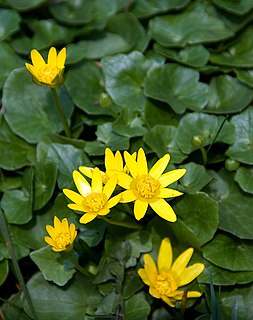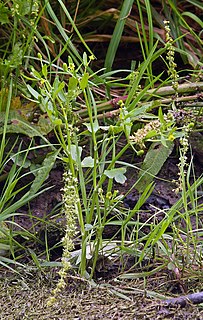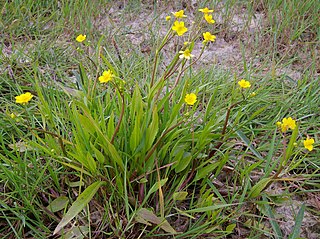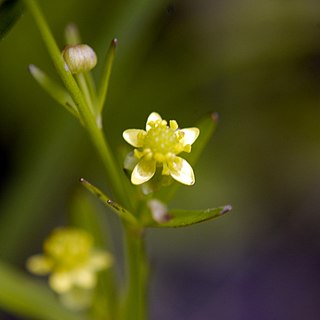
Ficaria verna, commonly known as lesser celandine or pilewort, is a low-growing, hairless perennial flowering plant in the buttercup family Ranunculaceae native to Europe and west Asia. It has fleshy dark green, heart-shaped leaves and distinctive flowers with bright yellow, glossy petals. It is now introduced in North America, where it is known by the common name fig buttercup and considered an invasive species. The plant is poisonous if ingested raw and potentially fatal to grazing animals and livestock such as horses, cattle, and sheep. For these reasons, several US states have banned the plant or listed it as a noxious weed. It prefers bare, damp ground and is considered by horticulturalists in the United Kingdom as a persistent garden weed; nevertheless, many specialist plantspeople, nursery owners and discerning gardeners in the UK and Europe collect selected cultivars of the plant, including bronze-leaved and double-flowered ones. Emerging in late winter with flowers appearing March through May in the UK, its appearance across the landscape is regarded by many as a harbinger of spring.

Ranunculaceae is a family of over 2,000 known species of flowering plants in 43 genera, distributed worldwide.

Ranunculus is a genus of about 500 species of flowering plants in the family Ranunculaceae. Members of the genus include the buttercups, spearworts and water crowfoots. The petals are often highly lustrous, especially in yellow species, owing to a special coloration mechanism: the petal's upper surface is very smooth causing a mirror-like reflection. The flash aids in attracting pollinating insects and temperature regulation of the flower's reproductive organs. Buttercups usually flower in the spring, but flowers may be found throughout the summer, especially where the plants are growing as opportunistic colonizers, as in the case of garden weeds.

An alpine garden is a domestic or botanical garden specialising in the collection and cultivation of alpine plants growing naturally at high altitudes around the world, such as in the Caucasus, Pyrenees, Rocky Mountains, Alps, Himalayas and Andes.

Trollius is a genus of about 30 species of plants in the family Ranunculaceae, closely related to Ranunculus. The common name of some species is globeflower or globe flower. Native to the cool temperate regions of the Northern Hemisphere, with the greatest diversity of species in Asia, trollius usually grow in heavy, wet clay soils.

An aggregate fruit or etaerio is a fruit that develops from the merger of several ovaries that were separate in a single flower. In contrast, a simple fruit develops from one ovary. In languages other than English, the meanings of aggregate and multiple fruit are reversed, so that aggregate fruits merge several flowers. The differences in meaning are due to a reversal in the terminology by John Lindley, which has been followed by most English-language authors.

Ranunculus lyallii, is a species of Ranunculus (buttercup), endemic to New Zealand, where it occurs in the South Island and on Stewart Island at altitudes of 700–1,500 m.

Ranunculus sceleratus known by the common names celery-leaved buttercup, celery-leaf buttercup, and cursed buttercup is a species of flowering plant in the buttercup family Ranunculaceae. It has a circumpolar distribution in the northern hemisphere, native to temperate and boreal North America and Eurasia, where it grows in wet and moist habitats, including ponds and streambanks.

Belsazar de la Motte Hacquet was a Carniolan physician of French descent in the Enlightenment Era. He was a war surgeon, a surgeon in the mining town of Idrija, and a professor of anatomy and surgery in Laibach. He researched the geology and botany of Carniola, Istria, and nearby places, and was the first explorer of the Julian Alps. He also did ethnographical work among the South Slavic peoples, particularly among the Slovene-speaking population. He self-identified primarily as a chemist and introduced the methods of chemical analysis to Carniola.

Ranunculus flammula, the lesser spearwort, greater creeping spearwort or banewort, is a species of perennial herbaceous plants in the genus Ranunculus (buttercup), growing in damp places throughout the Boreal Kingdom. It flowers June/July. Ranunculus flammula is poisonous. It is very closely related to R. reptans, which is distinguished by prostrate and more slender stems, narrower leaves and smaller flowers and is sometimes included within R. flammula sensu lato as a variety.

Ranunculus fluitans is a species of buttercup. It is a perennial water plant, that when in favourable conditions it can grow up to 6 m (20 ft) height.

Ranunculus lappaceus, commonly known as the common buttercup, Australian buttercup or Yarrakalgamba, is found across eastern Australia. Like buttercups elsewhere, it is a perennial herb with yellow flowers appearing in spring and summer.

Ranunculus abortivus is a species of flowering plant in the buttercup family, Ranunculaceae. Its common names include littleleaf buttercup, small-flower crowfoot, small-flowered buttercup, and kidneyleaf buttercup. It is widespread across much of North America, found in all 10 Canadian provinces as well as Yukon and the Northwest Territories, and most of the United States, except Hawaii, Oregon, California, and parts of the Southwest.

The Ljubljana Botanical Garden, officially the University of Ljubljana Botanical Garden, is the central Slovenian botanical garden, the oldest botanical garden in Southeastern Europe, and one of the oldest cultural, scientific, and educational organisations in Slovenia. Its headquarters are located in the Rudnik District of Ljubljana, the Slovenian capital, at Ig Street along the Gruber Canal to the southeast of Castle Hill. The garden started operating under the leadership of Franc Hladnik in 1810, when Ljubljana was the capital of the Illyrian Provinces. It is thus an averagely old European botanical garden. The institution is a member of the international network Botanic Gardens Conservation International and cooperates with more than 270 botanical gardens all across the world. Of over 4,500 plant species and subspecies that grow on 2 hectares, roughly a third is endemic to Slovenia, whereas the rest originate from other European places and other continents.

Ranunculus calandrinioides, the high alpine buttercup, is a species of flowering plant in the family Ranunculaceae, native to the Atlas Mountains of North Africa. Growing to 20 cm (8 in) tall by 15 cm (6 in) broad, it is an herbaceous perennial with broad, grey-green leaves which die down in summer, and white flowers, often tinged with pink, in winter and spring. It is one of the earliest buttercups to flower.

Ranunculus trichophyllus, the threadleaf crowfoot, or thread-leaved water-crowfoot, is a plant species in the genus Ranunculus, native to Europe, Asia and North America.
Ranunculus trivedii is a flowering plant in the buttercup family Ranunculaceae. It is one of the highest altitude flowering plants in the world.
Solms-laubachia himalayensis is a flowering plant in the family Brassicaceae. The specific epithet himalayensis is from the Latin, meaning "Himalayan".

Ranunculus fascicularis, commonly called early buttercup, is a species of flowering plant in the buttercup family (Ranunculaceae). It is native to the eastern North America, where it is found in Canada and the United States. It is generally widespread in eastern North America, although its populations become sporadic in areas east of the Appalachian Mountains and south of New England. Its natural habitat is in dry areas with sparse vegetation, such as rocky or sandy bluffs, prairies, and savannas.


















